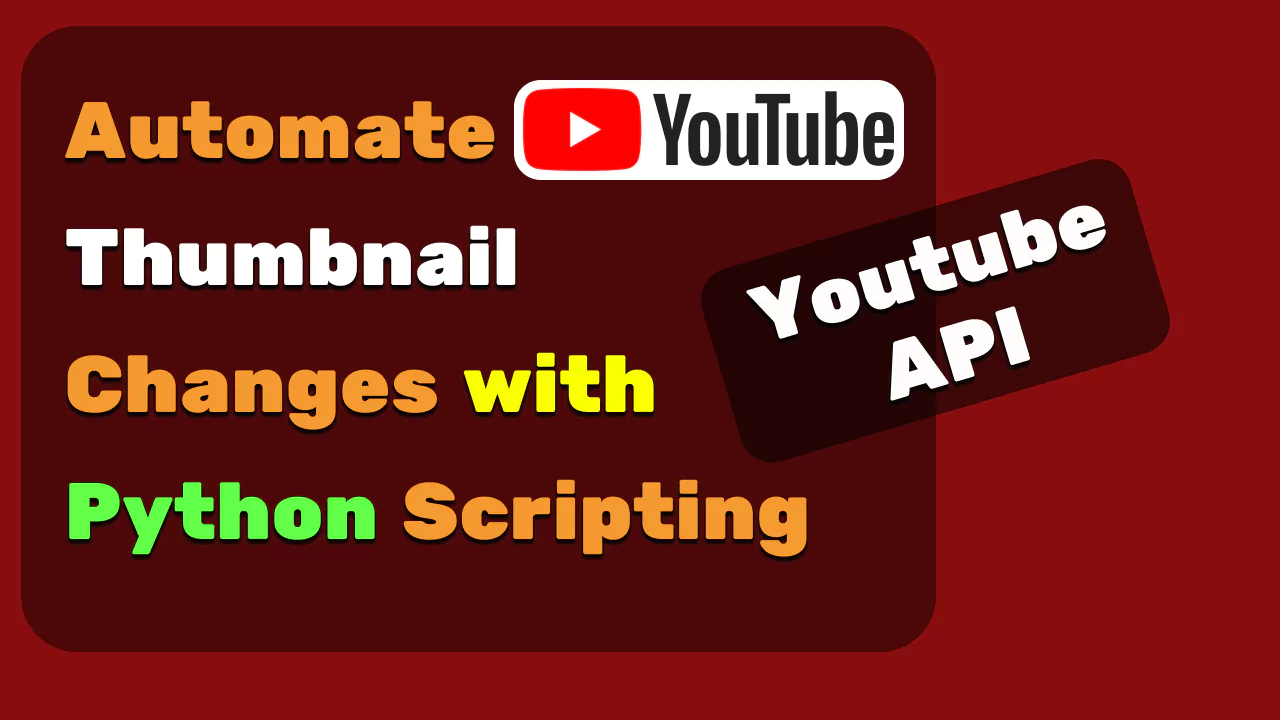YouTube Thumbnail changes with Python
Posted on February 20, 2024 • 6 minutes • 1089 words
YouTube thumbnails play a crucial role in attracting viewers and conveying the essence of your video.
Regularly updating your video thumbnails can enhance the visual appeal of your channel and encourage more clicks.
In this tutorial, we will explore how to automate YouTube thumbnail changes using a Python script.

Prerequisites
Before diving into the scripting process, make sure you have the following:
1. Google API Key:
Generate an API key from the Google Cloud Console with access to the YouTube Data API.
2. Playlist ID:
Identify the YouTube playlist for which you want to update thumbnails.
3. Client Secrets File:
Obtain the application_default_credentials.json file to authenticate your script.
4. Create the thumbnails:
- Create all thumbnails for the playlist and rename all files
as
1.png,2.png,…etc - save all files in
thumbsfolder
Setting up the Python Script & Script Overview
1. Importing Required Libraries
The script starts by importing necessary libraries for handling authentication, API requests, and file operations.
import time
import os
import google.auth
import google.auth.transport.requests
from googleapiclient.discovery import build
from google_auth_oauthlib.flow import InstalledAppFlow
from google.oauth2.credentials import Credentials
2. Authentication
It authenticates the script using OAuth2 credentials. If token information is not available or is expired, the script prompts the user to log in.
def get_authenticated_service(client_secrets_file):
# Set up OAuth2 credentials
credentials = None
if os.path.exists('token.json'):
credentials = Credentials.from_authorized_user_file('token.json')
# If credentials are not available or are invalid, let the user log in.
if not credentials or not credentials.valid:
if credentials and credentials.expired and credentials.refresh_token:
credentials.refresh(google.auth.transport.requests.Request())
else:
flow = InstalledAppFlow.from_client_secrets_file(
client_secrets_file, ['https://www.googleapis.com/auth/youtube.force-ssl']
)
credentials = flow.run_local_server(port=0)
# Save the credentials for the next run
with open('token.json', 'w') as token:
token.write(credentials.to_json())
# Set up the YouTube API service
youtube = build('youtube', 'v3', credentials=credentials)
return youtube
3. YouTube API Service
The script sets up the YouTube API service using the authenticated credentials.
youtube_service = get_authenticated_service(CLIENT_SECRETS_FILE)
# Set the playlist ID for which you want to retrieve videos
playlist_id = PLAYLIST_ID
4. Retrieving Playlist Videos
It retrieves all videos from the specified playlist using the get_playlist_videos function.
def get_playlist_videos(youtube, playlist_id):
# Retrieve all videos from the specified playlist
playlist_items = []
next_page_token = None
while True:
request = youtube.playlistItems().list(
part='snippet',
playlistId=playlist_id,
maxResults=50, # You can adjust this value based on your needs
pageToken=next_page_token
)
response = request.execute()
# Append videos to the list
playlist_items.extend(response['items'])
# Check for the next page
next_page_token = response.get('nextPageToken')
if not next_page_token:
break
return playlist_items
playlist_videos = get_playlist_videos(youtube_service, playlist_id)
5. Video Details
The script prints details of each video in the playlist, including video ID and title.
# Print video details
for video in playlist_videos:
video_id = video['snippet']['resourceId']['videoId']
video_title = video['snippet']['title']
videoTitleToId[video_title] = video_id
print(f"Video ID: {video_id}, Title: {video_title}")
6. Thumbnail Updates
For each video, the script identifies the corresponding thumbnail image and updates it using the set_video_thumbnail function.
def set_video_thumbnail(youtube, video_id, thumbnail_path):
# Upload the thumbnail image
request = youtube.thumbnails().set(
videoId=video_id,
media_body=thumbnail_path
)
response = request.execute()
print(f'Thumbnail updated successfully:\n{response}')
for i in range(1,36):
# Set the path to the new thumbnail image
thumbnail_path = "thumbs/" + str(i) + ".png"
video_id = ""
video_title = ""
for key in videoTitleToId.keys():
if str(i) in str(key):
video_title = key
video_id = videoTitleToId[key]
print(f"Video ID: {video_id}, thumbName: {thumbnail_path}, Title: {video_title}")
# Set the video ID for which you want to change the thumbnail
# Set the new thumbnail for the video
set_video_thumbnail(youtube_service, video_id, thumbnail_path)
time.sleep(10)
7. Running the Script
The main function calls all the necessary functions to execute the thumbnail update process.
python3 main.py
Full Code
Below is a Python script that automates YouTube thumbnail changes.
import time
import os
import google.auth
import google.auth.transport.requests
from googleapiclient.discovery import build
from google_auth_oauthlib.flow import InstalledAppFlow
from google.oauth2.credentials import Credentials
# Replace 'YOUR_API_KEY' with the API key you generated
API_KEY = ""
# Replace 'YOUR_PLAYLIST_ID' with the ID of the YouTube playlist
PLAYLIST_ID = 'PL9MpVynPwGzr_nBiH_jxWWzPo_kfcaD2n'
CLIENT_SECRETS_FILE = "application_default_credentials.json"
def get_authenticated_service(client_secrets_file):
# Set up OAuth2 credentials
credentials = None
if os.path.exists('token.json'):
credentials = Credentials.from_authorized_user_file('token.json')
# If credentials are not available or are invalid, let the user log in.
if not credentials or not credentials.valid:
if credentials and credentials.expired and credentials.refresh_token:
credentials.refresh(google.auth.transport.requests.Request())
else:
flow = InstalledAppFlow.from_client_secrets_file(
client_secrets_file, ['https://www.googleapis.com/auth/youtube.force-ssl']
)
credentials = flow.run_local_server(port=0)
# Save the credentials for the next run
with open('token.json', 'w') as token:
token.write(credentials.to_json())
# Set up the YouTube API service
youtube = build('youtube', 'v3', credentials=credentials)
return youtube
def get_playlist_videos(youtube, playlist_id):
# Retrieve all videos from the specified playlist
playlist_items = []
next_page_token = None
while True:
request = youtube.playlistItems().list(
part='snippet',
playlistId=playlist_id,
maxResults=50, # You can adjust this value based on your needs
pageToken=next_page_token
)
response = request.execute()
# Append videos to the list
playlist_items.extend(response['items'])
# Check for the next page
next_page_token = response.get('nextPageToken')
if not next_page_token:
break
return playlist_items
def set_video_thumbnail(youtube, video_id, thumbnail_path):
# Upload the thumbnail image
request = youtube.thumbnails().set(
videoId=video_id,
media_body=thumbnail_path
)
response = request.execute()
print(f'Thumbnail updated successfully:\n{response}')
def main():
# Get the authenticated YouTube API service
youtube_service = get_authenticated_service(CLIENT_SECRETS_FILE)
# Set the playlist ID for which you want to retrieve videos
playlist_id = PLAYLIST_ID
# Get all videos from the playlist
playlist_videos = get_playlist_videos(youtube_service, playlist_id)
videoTitleToId = {}
# Print video details
for video in playlist_videos:
video_id = video['snippet']['resourceId']['videoId']
video_title = video['snippet']['title']
videoTitleToId[video_title] = video_id
print(f"Video ID: {video_id}, Title: {video_title}")
for i in range(1,36):
# Set the path to the new thumbnail image
thumbnail_path = "thumbs/" + str(i) + ".png"
video_id = ""
video_title = ""
for key in videoTitleToId.keys():
if str(i) in str(key):
video_title = key
video_id = videoTitleToId[key]
print(f"Video ID: {video_id}, thumbName: {thumbnail_path}, Title: {video_title}")
# Set the video ID for which you want to change the thumbnail
# Set the new thumbnail for the video
set_video_thumbnail(youtube_service, video_id, thumbnail_path)
time.sleep(10)
if __name__ == "__main__":
main()

